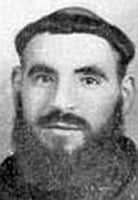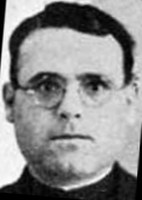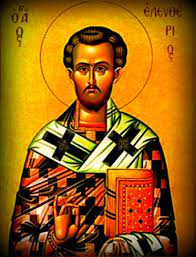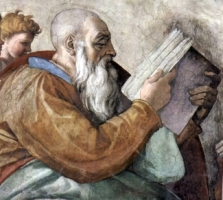Saint Magnus of Füssen
Also known as
• Apostle of the Algäu
• Maginaldus, Maginold, Magnoaldus, Mang
Profile
Priest. Benedictine. Spiritual student of Saint Columban and Saint Gall at Arbon (part of modern Switzerland). Superior of his house following the death of Saint Gall. At the request of the bishop of Augsberg, Bavaria, he evangelized in Eptaticus in the eastern part of Allgäu, Bavaria. By the River Lech in Bavaria, in a place still known as Sant Mangstritt (footstep of Saint Magnus) he founded the monastery of Füssen.
Some extraordinary stories grew up around Magnus, often involving animals. In Kempten he dispersed a plague of snakes. At Füssen, he was forced to expel a dragon from the land he needed for the monastery; in one version of the story, he spared an infant dragon who helped local farmers by hunting rats, mice and other crop-damaging vermin. While on a walk in the woods near the monastery, he encountered a bear who showed him a vein of iron ore; he gave the bear some cake. The bear followed Magnus back to the abbey where the saint rounded up some tools and monks; the bear then led them all to several other iron ore sources in the nearby mountains, thus helping found the area's most lucrative industry.
Died
c.666 at the monastery at Füssen, Bavaria (in modern Germany) of natural causes
Saint Frontiniano of Alba
Also known as
Frontinianus
Additional Memorials
• 23 October (dies natalis)
• 27 April (translation of relics in the diocese of Alba, Italy)
Profile
May have served as a soldier in an imperial Roman legion. Studied in his home town of Carcassonne, France, and became a deacon. Pilgrim to Rome, Italy with one Casiano, healing people along with way by praying for them, and performing other miracles including crossing a river on a piece of debris that floated up to carry him over. In Alba Pompeia, Italy, he expelled a demon from a teenager; the girl‘s parents converted and were baptized by Frontiniano, but the prefect of the city had him arrested and executed for the crime of being a Christian. Martyr.
Born
Carcassone, France
Died
• beheaded on 23 October 311 on the road outside the city walls of Alba Pompeia, Piedmont, Italy near the city cemetery
• a Benedictine abbey dedicated to Saint Frontiniano was later built on the site of his execution, and is the source of the information we have about him
• relics enshrined in the cathedral of Alba in the 15th century
• in the 16th century there developed a tradition of bringing sick children to be cathedral, carrying them nine times around the outside of the church, and then bringing them before the relics to pray for the intercession of Frontiniano
Blessed Olinto Marella
Also known as
Giuseppe Olinto Marella
Profile
One of three children of a wealthy physician who died when Olinto was only ten years old. Educated by his uncle, Archbishop Giuseppe Marella of Pallestrina, Italy. Studied in Rome, Italy, and was a class-mate of the future Pope John XXIII. Ordained on 17 December 1904. Taught seminarians in Chioggia, Italy and small children in his parish. Taught in a number of cities throughout Italy while continuing to study history, philosophy and theology. Parish priest in the diocese of Bologna, Italy, working with the poor, homeless and outcast of the city, finding funds for shelters, homes and chapels. Would sit on a stool on the street and preach to all passersby against indifference to the suffering of others. Some brother priests objected to his work as being too evangelical, but he had the support of Pope John XXIII.
Born
14 June 1882 in Pallestrina, Italy
Died
• 6 September 1969 in San Lazzaro di Savena, Italy of natural causes
• re-interred in 1980 in the Holy Family church, San Lazzaro di Savena
Beatified
• 4 October 2020 by Pope Francis
• the beatification was celebrated at Piazza Maggiore in Bologna, Italy, Cardinal Matteo Maria Zuppi presiding
Blessed Felipe Llamas Barrero
Also known as
Domitilo of Ayoó
Profile
Felipe joined the Franciscan Capuchins on 2 August 1923, taking the name Domitilo of Ayoó; he made his religious profession on 3 August 1924. Ordained a priest on 30 May 1931. He became known as a passionate preacher.
Father Domitilo was arrested on 3 August 1936 in the early days of the Spanish Civil War for the offense of being a priest and for continuing to preach in the streets after the war started. While in custody, he refused to remove his Capuchin habit, ministered to other prisoners, and spoke of forgiveness instead of revenge. His final acts, in the cemetery where he and 22 fellow prisoners were executed, was to give sacramental absolution to the other victims. Martyr.
Born
3 September 1907 in Ayoó de Vidriales, Zamora, Spain
Died
the night of 6 September 1936 in Peón cemetery, Gijón, Asturias, Spain
Beatified
• 13 October 2013 by Pope Francis
• beatification celebrated at the Complex Educatiu, Tarragona, Spain, presided by Cardinal Angelo Amato
Blessed Bertrand of Garrigue
Also known as
The Second Dominic
Profile
Priest. Worked with the Cistercians. Noted preacher. Fought Albigensianism. Worked with Saint Dominic de Guzman, and became his close friend and travelling companion. Joined the Dominicans in 1216 and helped them survive and thrive in their early years. Governed the first Dominican foundation in Paris, France, and helped establish their tradition of scholarship. Dominican provincial of Provence. Miracle worker. Died during the preaching of a mission to the Cistercian sisters of Saint Mary of the Woods.
Born
c.1195 at Garrigue, diocese of Nîmes, France
Died
• 1230 at Garrigue, diocese of Nîmes, France of natural causes
• buried in the cemetery of the Cistercian sisters of Saint Mary of the Woods
• his grave became a place of pilgrimage and site of miracles
• when there began to be large numbers of pilgrims, his relics were translated to nearby church
• relics destroyed by Protestants during the religious wars
Beatified
14 July 1881 Pope Leo XIII (cultus confirmed)
Saint Bega
ஆண்டென் நகர் புனிதர் பெக்கா
கைம்பெண், நிறுவனர், மடாலய தலைவர்:
பிறப்பு: ஜூன் 2, 613
லீஜ், வாலூன் பிராந்தியம், பெல்ஜியம்
இறப்பு: டிசம்பர் 17, 693
ஆண்டென், நாமூர் மாகாணம், வாலூன் பிராந்தியம், பெல்ஜியம்
அடக்கம் செய்யப்பட்ட இடம்:
தூய பெக்காவின் கல்லூரி தேவாலயம், ஆண்டென், நாமூர் மாகாணம், வாலூர் பிராந்தியம், பெல்ஜியம்
ஏற்கும் சமயம்:
ரோமன் கத்தோலிக்க திருச்சபை
கிழக்கு மரபுவழி திருச்சபை
நினைவுத் திருநாள்: செப்டம்பர் 6
பாதுகாவல்: பேகின்ஸ் (Beguines)
புனிதர் பெக்கா, பெல்ஜியம் (Belgium) நாட்டிலுள்ள "ஆண்டென்" (Andenne) நகரில், ஏழு ஆலயங்களையும், ஒரு பள்ளியையும் கட்டி நிறுவியவர் ஆவார்.
இவர், "ஆஸ்ட்ரேஸியா அரண்மனையின்" (Palace of Austrasia) மேயரான "பெப்பின்" (Pepin of Landen) என்பவரது மூத்த மகளாவார். இவரது தாயாரின் பெயர், "இட்டா" (Itta of Metz) ஆகும்.
புனிதர் கெட்ரூட் (Gertrude of Nivelles) என்பவரின் மூத்த சகோதரியான இவர், "மெட்ஸ்" ஆயரான (Bishop of Metz) "அர்னால்ஃப்" (Arnulf) என்பவரின் மகனான "அன்ஸேகிஸேல்" (Ansegisel) என்பவரை மணமுடித்தார்.
இவரது கணவர் "அன்செஜிசலின்" (Ansegisel) மரணத்தின் பின்னர், அப்போதைய யூத, கிறிஸ்தவ, இஸ்லாமிய பாரம்பரியங்களின்படி, முக்காடுள்ள ஆடையை (Veil) தேர்வுசெய்துகொண்ட இவர், ரோம் நகருக்கு புனித யாத்திரை மேற்கொண்டார்.
புனித யாத்திரையிலிருந்து திரும்பியதும், ஏழு தேவாலயங்களை நிறுவினார். மற்றும் மியூஸ் நதிக்கரையிலுள்ள (Meuse River) (ஆண்டென் சுர் மியூஸ்) (Andenne sur Meuse) ஆண்டென் (Andenne) நகரில், ஒரு கான்வென்ட் பள்ளியையும் கட்டினார். அங்கு தனது எஞ்சிய நாட்களை மடாலய தலைவராக கழித்த இவர், அங்கேயே கி.பி. 693ம் ஆண்டு, டிசம்பர் மாதம், பதினேழாம் தேதி, மரித்தார்.
இவர், பெல்ஜியம் நாட்டின், நாமூர் மாகாணத்திலுள்ள, ஆண்டென் நகரத்தின் தூய பெக்காவின் கல்லூரி தேவாலய வளாகத்தில் அடக்கம் செய்யப்பட்டார்.
இவரை கத்தோலிக்க திருச்சபையும், கிழக்கு மரபுவழி திருச்சபையும் புனிதராக ஏற்கின்றன
Also known as
Bee, Begga, Begh
Profile
Born to the Irish royalty. Bega's family arranged her a marriage to the Prince of Norway, but Bega wanted to devote her life and virginity to the Lord, refused the arrangement, and fled; legend says she was carried across the sea to the coast of Cumberland by riding on a clod of earth.
She lived as an anchoress in Cumberland for many years, fed by the birds in the woods. Saint Oswald of Northumbria, on a raid to dispel some highwaymen, convinced her to enter a convent for her own safety. She agreed, and took the veil from Saint Aiden of Lindesfarne.
Founded a monastery which later was named after her, and around which grew the town of Saint Bee's Head in Cumberland, England. Abbess. Known for generosity to the poor and oppressed who came to the abbey for assistance. The village of Kilbees, Scotland was also named after her.
Born
7th century Ireland
Died
681 of natural causes
Blessed Diego Llorca Llopis
Also known as
Didaco Llorca Llopis
Profile
Born to a pious family, Didaco early felt a call to the priesthood. He studied at the seminary in Valencia, Spain, and was ordained a priest in the archdiocese of Valencia in 1925. Father Didaco served as a co-adjutor in the parishes of Setla-Mirarrosa, Miraflor, Denia and Benissa where he was known as a friendly, gentle pastor, dedicated to teaching the catechism. When the Spanish Civil War began in earnest, Didaco returned to his home town to try to ride out some of the persecution, but was caught, imprisoned on 5 September 1936, and murdered the next day for the crime of being a priest. Martyr.
Born
2 July 1896 in Oliva, Valencia, Spain
Died
shot at dawn on 6 September 1936 in Gata de Gorgos, Alicante, Spain
Beatified
11 March 2001 by Pope John Paul II
Saint Onesiphorus
Also known as
Onacepherous
Profile
First-century convert. Relative of Saint Porphyrius. Sheltered, supported, worked with and visited Saint Paul the Apostle in prison. Missionary through Spain and to the Hellespont. Martyred in the persecutions of emperor Domitian.
Died
torn apart by wild horses in Parium on the shores of the Hellespont (near modern Kemer, Turkey)
Blessed Tomás Ramírez Caba
Profile
Married layman and father of the diocese of Quiché, Guatemala. He served as sacristan in his parish. Martyr.
Born
30 December 1934 in Chajul, Quiché, Guatemala
Died
6 September 1980 in Chajul, Quiché, Guatemala
Beatified
• 23 April 2021 by Pope Francis
• beatification recognition celebrated in Santa Cruz del Quiché, Guatemala
Saint Eleutherius the Abbot
புனித எல்யூடேரியஸ்
நினைவுத்திருநாள் : செப்டம்பர் 6
பிறப்பு : (தெரியவில்லை)
இறப்பு : 585, உரோம், செயிண்ட் ஆண்ரூ ஆலயம் (St. Andrew’s Church, Rome)
எல்யூடேரியஸ் அற்புதமான எளிமையான வாழ்வை வாழ்ந்தார். மனசாட்சியின் குரலுக்கு முக்கியத்துவம் கொடுத்து, தூய ஆவியானவர் காட்டிய வழியில் சென்றார். ஸ்பொலேட்டோ (Spoleto) என்ற நகரிலிருந்த புனித மார்க்கின் துறவற மடத்தில் சேர்ந்து குருவாக திருநிலைப்படுத்தப்பட்டார். குருவான சில ஆண்டுகளில் துறவற மடத்திற்கு மடாதிபதியாக தேர்வு செய்யப்பட்டார். கடவுளின் அருளால் பல அற்புதங்களை செய்தார்.
இவர் தன் மடத்தில் குழந்தைகளுக்கு கல்வி கற்றுக்கொடுக்கும் பணியை ஆற்றினார். அப்போது ஒருநாள் சாத்தான் இவரை சோதிக்க வந்தது. ஆனால் இவரின் இறைபக்தியை கண்டு சாத்தான் பயந்து ஓடிவிட்டது. ஆனால் மீண்டும் சாத்தான் குழந்தையின் வடிவில் வந்து சோதித்தது. பின்னர் ஒரு குழந்தைக்குள் புகுந்தது. அக்குழந்தை சாத்தான் கடுமையாக தாக்கி, நோயை உண்டாக்கியது. இதனைக் கண்ட எல்யூடேரியஸ் மற்றும் அவரது குழும உறுப்பினர்களும் இணைந்து தவமிருந்தும் கடினமான நோன்பிருந்தும் செபித்தனர். இறைவேண்டலால் சாத்தானின் பிடியிலிருந்து குழந்தை விடுபட்டது. ஆனால் குழந்தை மிகவும் சோர்ந்து பலவீனத்துடன் காணப்பட்டது. சாகும்தறுவாயில் குழந்தை இருந்தது இதனால் அக்குழந்தையை எல்யூடேரியஸ் செயிண்ட் ஆன்ரூஸ் பேராலயத்திற்கு எடுத்து சென்றார்.
இவர் அப்பேராலயத்தில் கடின நோயிலிருந்து இடைவிடாமல் இறைவேண்டலில் ஈடுபட்டு குழந்தையை பழைய நிலைக்கு கொண்டு வந்தார். அக்குழந்தை மீண்டும் புந்து உயிர்பெற்றது. அதிலிருந்து இவர் தொடர்ந்து கண்ணீர் வடித்து திருச்சபைக்காகவும், மக்களுக்காகவும் மன்றாடினார். வாழ்நாள் முழுவதும் நோன்பிலிருந்து பல அருள் கொடைகலை பெற்றார். அதிகமாக நோன்பிருந்ததால் உடல் முழுவதும் சக்தி இழந்து காணப்பட்டார். இதனால் தன் தலைவர் பதவியை விட்டு விலகி செபிப்பதில் மட்டுமே இறக்கும்வரை தன் வாழ்வை கழித்தார்.
Also known as
Eleutherius of Spoleto
Profile
Abbot of Saint Mark's Abbey, Spoleto, Italy. Monk in Rome, Italy under the direction of Saint Gregory the Great who wrote about him and described him as a miracle worker and exorcist.
Died
• c.585 at the monastery of Saint Andrew in Rome, Italy
• relics later translated to Spoleto, Italy
Zacharius the Prophet
Also known as
Zaccaria, Zechariah
Profile
Son of Barachius. Old Testament prophet in the reign of King Darius. He began his ministry c.520 BC, two months after Haggai the Prophet. His work has both an allegorical history of his people, and prophecies of the Messiah to come.
Died
6th century BC
Saint Augebert of Champagne
Profile
Captured in England and sold into slavery in France. Ransomed out of slavery by Saint Gregory the Great. Ordained as a deacon and trained as a missionary, he planned to return to England, but was murdered by pagans in before he could leave. Martyr.
Born
England
Died
martyred in the 7th century in Champagne (in modern France
Saint Felix of Champagne
Profile
Captured in England and sold into slavery in France. Ransomed out of slavery by Saint Gregory the Great. Ordained as a priest and trained as a missionary, he planned to return to England, but was murdered by pagans in before he could leave. Martyr.
Born
England
Died
7th century in Champagne (in modern France)
Saint Maccallin of Lusk
Also known as
• Macallan of Lusk
• Macculin Dus
Profile
Bishop of Lusk, Ireland where he lived in a cave while building a church and founding a monastery in the village.
Born
Irish
Died
• c.497 of natural causes
• buried in a cave near Lusk, Ireland
Saint Cagnoald of Laon
Also known as
Cagnou, Chagnoald, Chainaldus, Chainoaldus
Profile
Brother of Saint Faro of Meaux and Saint Burgundofara. Monk at Luxeuil, France. Spiritual student of Saint Columbanus with whom he travelled to Bobbio, Italy where they founded a monastery. Sixth bishop of Laon, France.
Died
633
Saint Sanctian of Sens
Profile
Brother of Saint Augustine of Sens and Saint Benedicta of Sens. During the persecution of Christians in Spain by Aurelian, he fled to Sens, Gaul (in modern France), which was no friendlier. Martyr.
Born
Spain
Died
martyred in 273 in Sens, France
Saint Augustine of Sens
Profile
Brother of Saint Benedicta of Sens and Saint Sanctian of Sens. During the persecution of Christians in Spain by Aurelian, she fled to Sens, Gaul (in modern France), which was no friendlier. Martyr.
Born
Spain
Died
273 in Sens, France
Saint Gondulphus of Metz
Also known as
Gundulfus, Gondulf, Gondon
Profile
Priest. Bishop of Metz, France, December 816.
Died
• 6 September 823 of natural causes
• buried in the monastery of Gorze
Saint Macarius of Alexandria
Profile
Martyred in the persecutions of Decius.
Died
beheaded in 250 at Alexandria, Egypt
Saint Faustus of Alexandria
Profile
Martyred in the persecutions of Decius.
Died
beheaded in 250 at Alexandria, Egypt
Saint Faustus of Syracuse
Profile
Abbot of Santa Lucia monastery in Syracuse, Sicily. Teacher of Saint Zosimus of Syracuse.
Died
c.607 of natural causes
Saint Beata of Sens
Profile
During a persecution of Christians in Spain, he fled to Sens, Gaul, which was no friendlier. Martyr.
Born
Spain
Died
273
Saint Eve of Dreux
ட்ரூக்ஸின் புனித ஈவ் ஒரு கிறிஸ்தவ மறைசாட்சி ஆவார், அவர் கி.பி 3 ஆம் நூற்றாண்டில் கொல்லப்பட்டார். அவர் பிரான்சின் ட்ரூக்ஸ் நகரின் பாதுகாவலர்
அவர் ட்ரூக்ஸில் பிறந்தார், மேலும் அவர் ஒரு பக்தியுள்ள கிறிஸ்தவராக இருந்தார். அவள் நம்பிக்கையை கைவிட மறுத்ததற்காக ரோமானிய அதிகாரிகளால் கைது செய்யப்பட்டாள், அவள் தலை துண்டிக்கப்பட்டு கொல்லப்பட்டார்
பாரம்பரியத்தின் படி, ட்ரூக்ஸில் உள்ள செயிண்ட்-பியர் தேவாலயத்தின் தளத்தில் ஈவ் தலை துண்டிக்கப்பட்டார். அவளுடைய நினைவுச்சின்னங்கள் அந்த தேவாலயத்தில் பாதுகாக்கப்படுவதாக கூறப்படுகிறது.
அவரது விழா செப்டம்பர் 5,6 அன்று கொண்டாடப்படுகிறது.
அவருக்கு அர்ப்பணிக்கப்பட்ட ஒரு தேவாலயம் 17 ஆம் நூற்றாண்டில் ட்ரூக்ஸில் கட்டப்பட்டது.
ட்ரூக்ஸில் உள்ள ப்ளேஸ் டி லா ரிபப்ளிக் என்ற இடத்தில் அவரது சிலை உள்ளது.
Patronage
Dreux, France
Saint Petronius of Verona
Profile
Bishop of Verona, Italy. Noted for establishing ministries to the poor.
Died
c.450
Saint Cottidus of Cappadocia
Profile
Deacon. Martyr.
Died
martyred in Cappadocia
Saint Arator of Verdun
Profile
Fourth bishop of Verdun, France.
he was the fourth bishop of Verdun, France. He is not mentioned in any other reliable sources, so it is likely that he is a fictional saint.
Died
c.460
Saint Imperia
Profile
Honoured in Mauprévoir, France, but no information about her has survived.
The earliest mention of Saint Imperia is in a 15th century manuscript that lists her as one of the saints of Mauprévoir. However, the manuscript does not provide any details about her life or martyrdom.
In the 17th century, a local historian named Jean Lebeuf wrote a book about the saints of Mauprévoir. He included a chapter on Saint Imperia, but his account is also based on speculation and legend.
Today, Saint Imperia is still honored in Mauprévoir. There is a chapel dedicated to her in the village, and her feast day is celebrated with a procession and a Mass.
Martyrs of Africa
Profile
There were thousands of Christians exiled, tortured and martyred in the late 5th century by the Arian King Hunneric. Six of them, all bishops, are remembered today; however, we really know nothing about them except their names and their deaths for the faith - Donatian, Fusculus, Germanus, Laetus, Mansuetus and Praesidius.
Martyred in the Spanish Civil War
• Blessed Antonio Frutos Tena Amaya
• Blessed Diego Llorca Llopis
• Blessed Felipe Llamas Barrero
• Blessed Francisco Escura Foix
• Blessed Pascual Torres Lloret
• Blessed Vidal Ruiz Vallejo
Liberato of Loro Piceno
Liberato da Loro (Loro Piceno, 1189-1190 – Sarnano, 1231-1234), also known as Saint Liberato, was an Italian Franciscan. His cult as a blessed was confirmed, first by Pope Clement XI on September 2, 1713, and again by Pope Pius IX in 1868.
He was born between 1189 and 1190 in Loro Piceno, in the Fermano region, into a noble feudal family, the Da Loro. Following in the footsteps of Saint Francis, he left all his possessions and comforts to give his soul and body to God.
The Order of Friars Minor identifies him with the Holy Anonymous who lived in the hermitage of Soffiano of which the Actus beati Francisci et sociorum eius and the Little Flowers of Saint Francis (chapter 47), original Latin text by Friar Ugolino da Montegiorgio, speak.
In Soffiano, a place of solitude around Sarnano, where the ruins of an old convent can still be seen today, Liberato took the habit of the Franciscans. He led a life of contemplation, of a hermit type, and is presumed to have been involved with Brothers Humble and Pacific in a project to safeguard the strict observance of the order's rule.
Liberato died in the hermitage of Soffiano after receiving the comfort of the Virgin Mary and three holy virgins who appeared to him with a multitude of angels.
Liberato is remembered for his holiness, his love for God and his neighbor, and his great devotion to the Virgin Mary. He is also known for his miracles, such as the healing of the sick and the conversion of sinners.












